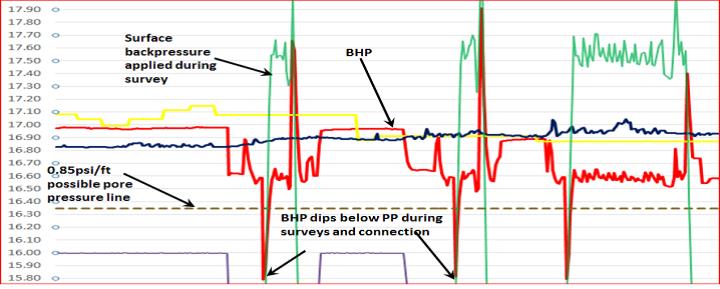
Well control event when using an MPD system
A High Pressure exploration gas-condensate bearing reservoir section was being drilled using automated Managed Pressure Drilling (MPD) and Rig Pump Divertor (RPD) equipment. Total gas and Connection Gas (TG/CG) peaks were noted the day before during drilling so the degasser was run. The drilled stand was backreamed at normal drilling flow rate prior to taking a MWD survey, making a connection and then taking Slow Circulating Rates (SCRs) on all 3 mud pumps. During taking SCRs an initial pit gain of 16bbl was noticed and reported.
It was suspected that pit gain was continuing, so a dynamic flow check was carried out in which it was confirmed that the well was flowing. Subsequently the well was shut in on the BOP (SICP=5,800psi, SIDPP=0psi). Dual float valves behind the bit were holding; total pit gain was estimated at 306bbls. Due to high casing pressure/MAASP concerns, an attempt was made to lower the annulus casing pressure by bleeding off gas through the choke and ‘poor boy’ mud-gas separator (MGS). This attempt was quickly aborted due to inadequate choke control leading to loss of the MGS liquid seal (SICP=7,470psi, SIDPP=0psi (floats holding).
After mobilization of high pressure bleed down facilities, the casing pressure was successfully reduced to zero psi through the “Lubricate and Bleed” well control method.
What Went Wrong?:
During “pump off” events the Bottom Hole Pressure (BHP) dropped below Pore Pressure (Po) which resulted in initial small influxes into the wellbore. These were not recognized and therefore not reported as and when they occurred.
In MPD-RPD mode, fluid density dropped below the setpoint of 16.6 ppg (0.86 psi/ft) during pump off events (first and second survey and connections) due to a ‘sluggish’ RPD auto-choke. The RPD system had not been properly calibrated and the choke not run in the optimum position for effective control.
The formation pressure gradient of the gas-condensate bearing reservoir was evaluated to be 0.84psi/ft (Po~13,950psi).

Corrective Actions and Recommendations:
- Comprehensive and clear communication and action protocols (eg. close-in) should be tested, and verified as effective, across all Crews and Shifts.
- Drillers must be clear that immediately on detecting an influx, they need to shut-in the well (applies for both MPD and non-MPD operations). The deployment of MPD does not change this basic principle.
- Choke drills (A/B Crews and Day/Night shifts), including operation of remote choke(s) through a remote choke control panel, are critical to verifying that the total system (equipment, procedures, people including actions and communication protocols) are effective to operate the chokes against the maximum anticipated casing pressure.
safety alert number: 272
IOGP Well Control Incident Lesson Sharing http://safetyzone.iogp.org/
Disclaimer
Whilst every effort has been made to ensure the accuracy of the information contained in this publication, neither the IOGP nor any of its members past present or future warrants its accuracy or will, regardless of its or their negligence, assume liability for any foreseeable or unforeseeable use made thereof, which liability is hereby excluded. Consequently, such use is at the recipient's own risk on the basis that any use by the recipient constitutes agreement to the terms of this disclaimer. The recipient is obliged to inform any subsequent recipient of such terms.
This document may provide guidance supplemental to the requirements of local legislation. Nothing herein, however, is intended to replace, amend, supersede or otherwise depart from such requirements. In the event of any conflict or contradiction between the provisions of this document and local legislation, applicable laws shall prevail.
